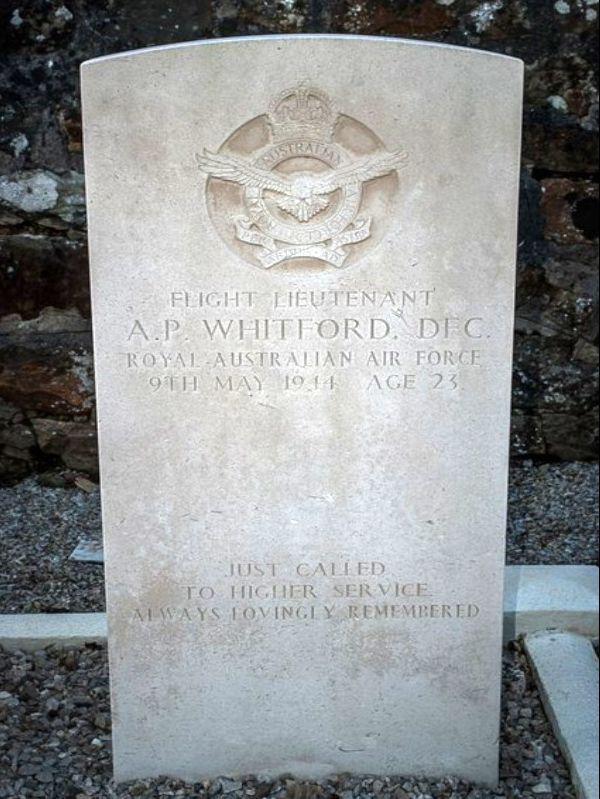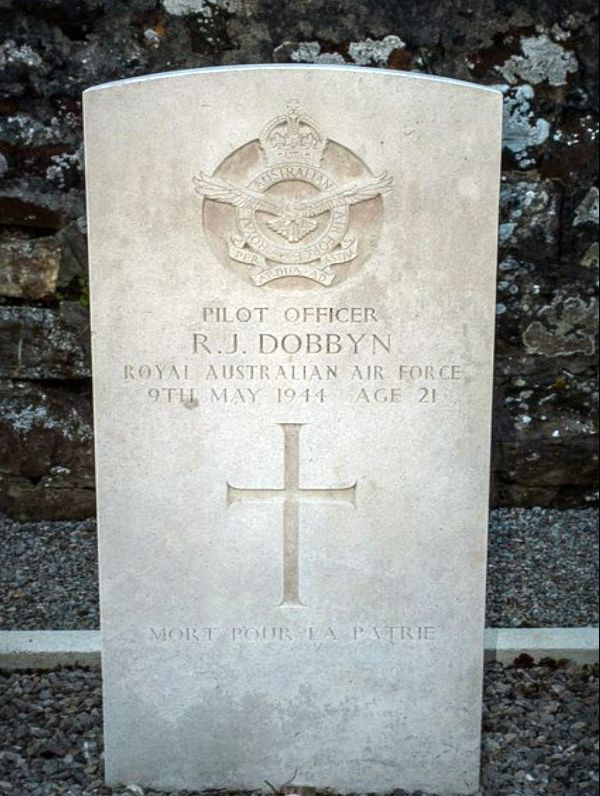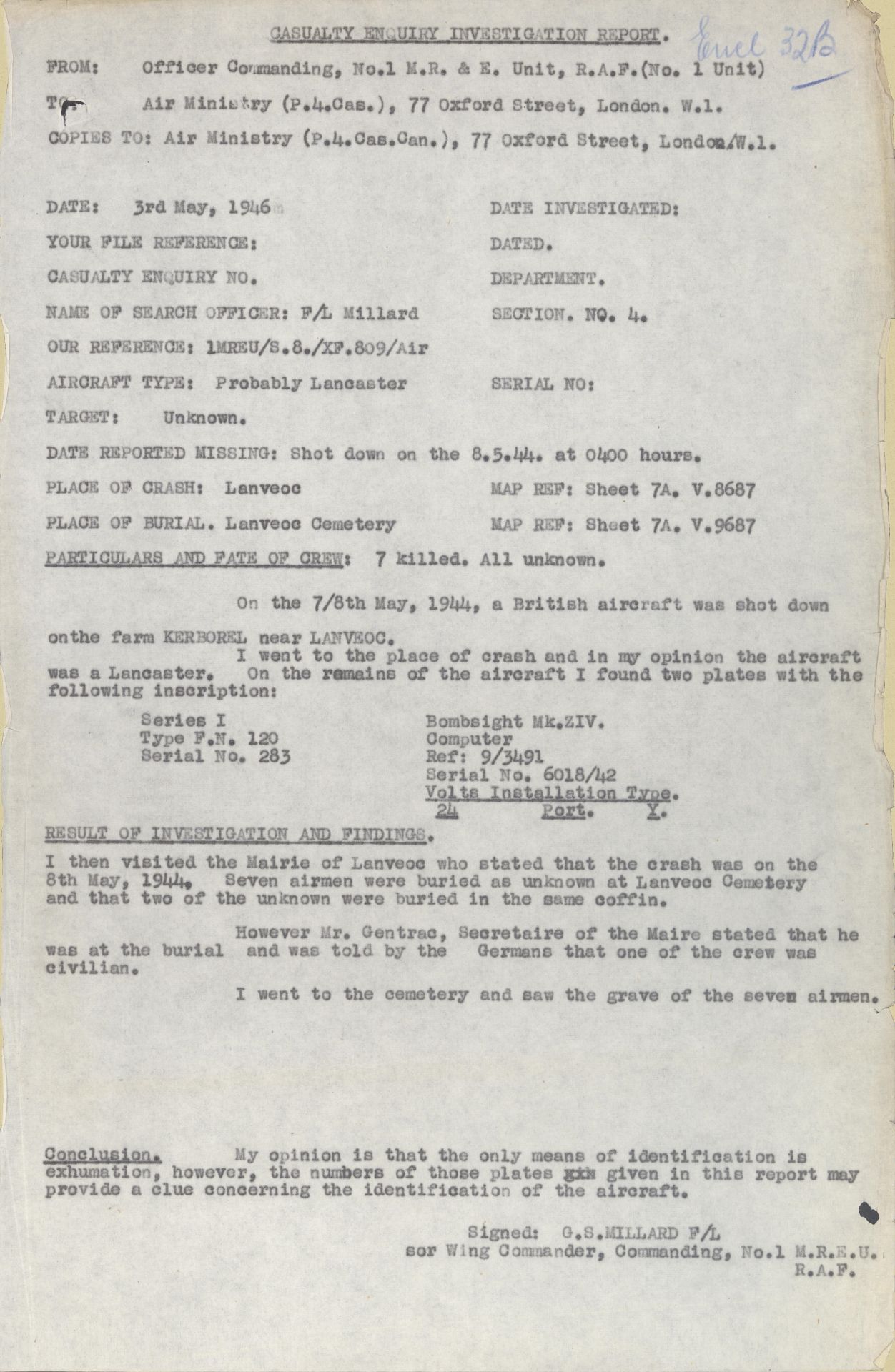Avro Lancaster Mk III (ND818 code OL-T)
"Kerborhel", Lanvéoc Poulmic (29)
(contributors : Daniel Dahiot, Jean-Louis Sévellec, Jean-Louis Roba, Frédéric Hénoff, France Crashes 39-45)

Avro Lancaster of No. 83 Squadron of the RAF
Photo Imperial War Museum © IWM CH6073
Crew (No. 83 Squadron RAF)

all crew members buried in Lanveoc cemetery
- Flight Lieutenant (pilot) Allan Pluis WHITFORD, aged 23, DFC, RAAF (service number 406587).
Son of Percy Russell and Hilda Grace Whitford, Rivervale, Western Australia.
Common grave 8-10

Flight Lieutenant WHITFORD
Photo Australian War Museum taken on December 1943 (ref. UK0886) - Public domain
- Flight Lieutenant (navigator) Watson Temple LOFTUS, aged 22, DFC, RAAF (service number 420573).
Son of Roderick William and Sarah Althea Mildred Loftus, Homebush, New South Wales, Australia.
Grave 7
- Sergeant (flight engineer) Harold George MILLARD, RAF Volunteer Reserve, (service number 1165720).
Grave 6
- Pilot Officer (bomb aimer) Robert Joseph DOBBYN, aged 21 ans, RAAF (service number 414211).
Son of Henry Denis and May Rosalie Dobbyn, Toowoomba, Queensland, Australia.
Common grave 8-10
- Pilot Officer (Wireless operator) Newman Jack HIGGINS, aged 20, RAAF (service number 420192).
Son of James Marming and Alice Kate Higgins, Petersham, New South Wales, Australia.
Common grave 8-10
- Warrant Officer (air gunner) Dennis Harold James CROSS, aged 22, RAF Volunteer Reserve (service number 1313572).
Son of Robert James and Tressie M. E. Cross, Oxford, England.
Common grave 8-10
- Flight Sergeant (air gunner) Leonard William John ARNOLD, RAF Volunteer Reserve (service number 1330980).
Common grave 8-10
THE STORY
On the night of 8-9 May 1944, fifty-eight Lancasters and six Mosquitos attacked the Lanvéoc-Poulmic airfield and seaplane base. At the end of this raid, a single four-engine aircraft was reported missing with its entire crew, Lancaster ND818 code OL-T of No.83 Squadron.
For this mission, Nos. 9, 50, 61, 463 and 467 Squadrons each detached eleven Lancasters. The target was to be spotted by experienced Pathfinder crews, three Lancasters from No. 83 Squadron and six Mosquitos from No. 627 Squadron. It should be noted that Nos. 463 and 467 were Australian Squadrons. Initially, the six Mosquitos dropped pyrotechnic markers known as Ground Markers, then during the bombing, the three Lancasters continued the marking with other fireworks and also dropped bombs. The crew of ND818 was made up of experienced men; pilot F/O Allan P. WHITFORD, navigator P/O Watson T. LOFTUS and top turret gunner W/O Dennis H.J. CROSS had each flown 39 operational sorties. Bomb aimer P/O Robert J. DOBBYN and rear gunner F/Sgt. Leonard WJ ARNOLD flew 38 sorties ; wireless operator W/O Newman J. HIGGINS and flight engineer Sgt Harold G. MILLARD flew 35 and 37 sorties respectively.
As dusk began to fall over RAF Coningsby, the crew of ND818 assembled and boarded the truck that would take them across the field to their aircraft. It was a virtually new Avro Lancaster Mark III – it had been taken into account by the Squadron on 14th April. On arrival, the men disembarked and were greeted by the Crew Chief, the chief engineer, who declared the aircraft ready for service. F/O Whitford, who acted as the Captain, then signed the acceptance papers and the aircraft officially became his. Alan Whitford, the pilot, like three other members of his crew, was Australian, originally from Perth. He had been awarded the Distinguished Flying Cross in December 1943 while flying with No.467 Squadron. He was 23 years old. Harold Millard, the flight engineer, helped his pilot with the pre-take-off checks. During the flight, his job is to monitor and control the complex systems and assist the pilot during the mission. Leonard Arnold climbed into the rear of the aircraft. He occupied the loneliest and coldest position of the crew, that of tail gunner. He was so cramped in his turret that he has to hang his parachute from a hook located further in the fuselage.

Map of Lanveoc from 1943. To the east of Lanveoc, the Kerborel farm (circled in orange) where the parts of Lancaster ND818 fell
Source US National Archives
The top gunner was Dennis Cross, a 22-year-old veteran. He sat on a canvas seat behind two machine guns in a turret behind the wings. He had to constantly scan the sky for enemy aircrafts, but also for an aircraft from his own formation whose trajectory might put him too close. The navigator was another Australian, Watson Loftus, from Homebush in New South Wales. For the moment he settled into his post, focused on his maps and activated the various electronic navigation aids. He was 22 years old. Almost next to him was Newman Higgins, the wireless operator, a compatriot from Earlwood in New South Wales, who switched on and adjusted his radio equipment. At 20, he was the youngest of the crew. Finally there was bomb aimer Robert Dobbyn, also an Australian, 21 years old, from Queensland. His position was in the nose of the aircraft after take off, but it was forbidden during takeoff or landing, so for now he had found a place in a corner behind the main spar, in the middle of the aircraft. He tried not to think about the bomb load just under his buttocks.
ND818 took off at 21:16, from this moment on we did not hear anything more about the aircraft, we knew that it had reached the objective and we can only imagine its last moments. Allan Whitford and his men began their attack. Robert Dobbyn was lying in the nose of the aircraft, concentrating on positioning the flare markers on the target. The aircraft must have flown straight and level for ten seconds ; the gunners scanned the sky ; Harold Millard, meanwhile, monitored the engine data in case one of them showed signs of weakness; he was also ready to help his pilot in case the latter was injured at a critical moment. Watson Loftus could only remain seated at his post; as navigator, he prepared for the return route and Newman Higgins listened to the various radio messages between aircrafts. The bomb bay doors of the T-Tommy slowly opened.
The light flak fire intensified, as it had been announced at the briefing. The Lancaster was shaked in flight by the explosions ; from all directions in the night sky rised lazily the luminous curves of the tracers while the searchlights scanned the sky in search of prey. Concentrated, Dobbyn tried to locate his release point through the viewfinder, to align the reticle and finally to press the switch which will release his load of ammunition. Suddenly, just over the target, a huge flash of light illuminated the sky. The ND818 has just disintegrated in flight, hit by a direct flak hit ; its debris littered the target and its surrounding area including the Kerborhel farm sector.
The Germans recovered five bodies ; if Millard, Loftus and Whitford could be identified using their registration plates, two of their comrades could not be identified and two were not found at the time of the report to the Luftgaukommando-Westfrankreich by the Fliegerhorst-Kommandantur Brest-Poulmic. All were then buried in the cemetery of Lanvéoc-Poulmic. Allan P. Whitford and Watson T. Loftus were recipients of the Distinguished Flying Cross, awarded to them in December 1943 for the former, and in April 1944 for the latter – they were then members of No. 467 Squadron. It is worth noting that the entire crew came from No. 467 Squadron, all of its members having been assigned at the same time to No. 83 Squadron. Today, their graves are maintained by the community with the support of the Commonwealth War Graves Commission which maintains the graves of British soldiers throughout the world.

Report from the Fliegerhorst-Kommandantur Brest-Poulmic stating that 5 men were killed (3 identified) and 2 were missing
GUSTAV VON HOLTEN
During the bombing of May 9, 1944, the aviator Gustav von Holten was stationed in Lanvéoc. He belonged to the 3.Kompanie of Flieger-Regiment 32. He was killed during the raid of the Lancasters. He was born on November 21, 1926 in Rosenheim (northern Bavaria) and was 18 years old. Below is his death notice.


Gustav von Holten's Obituary.
Documents collection Jean-Louis Roba

The death notice of Gustav von Holten.
Document's source : Fold3 "Germany, Military Killed in Action 1939-1948" - origin Bundearchiv
IN MEMORIAM
♦ Graves of the seven airlen of Lancaster ND818 in the communal cemetery of Lanvéoc
(photos L. Vaillant via France Crashes 39-45)


Flight Lieutenant WHITFORD Flight Lieutenant LOFTUS


Sergeant MILLARD Pilot Officer DOBBYN


Pilot Officer HIGGINS Warrant Officer CROSS

Flight Sergeant ARNOLD
APPENDICES
♦ Casualty report dated May 3, 1946.
(source National Archives of Australia, reference A705, 166/25/153)
This document tells us that the aircraft was shot down around 4 am. The investigator thinks that it was probably a Lancaster. However, he makes a mistake on the date by indicating the night of 7 or 8 May 1944. It is specified that the aircraft fell at Kerborel and that the crew was buried in the Lanvéoc cemetery. We learn that two airmen were buried in the same coffin. The Germans are said to have told the town hall secretary, Mr Gentrac, at that time, that one of the crew members was a civilian.

♦ Operational Record Book of No. 83 Squadron for the date of 9th May, 1944
(source documents : The National Archives)
- the 1st page of this document reveals that the Squadron was requested for a new mission for the night of 8 to 9 May 1944 and that 3 crews were designated : that of F/L Pidding (aircraft coded OL-O), of F/O Siddle (aircraft coded OL-V) and of F/O Whitford (aircraft coded OL-T). The target of the mission was Lanvéoc airfield, near Brest. The attack is described as having been successful as the airfield was put "non-operational". But the report states also that the Squadron suffered a severe blow with the loss of Whitford's crew, a crew described as experienced, with "very keen types". Their loss was deeply felt by all.
- the 2nd page of the document lists the crew members of Lancaster ND818. We learn that the plane took off at 9:16 p.m., that unfortunately there was no news after takeoff and that it was reported missing.

Document AIR-27-688-9

Document AIR-27-688-10
♦ Photographs of the target the day of the mission
(source "International Bomber Command Centre")


Ajouter un commentaire